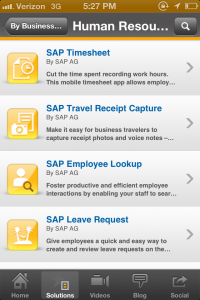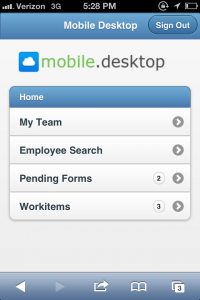Alright, maybe the title is a bit extreme, but I have seen a lot of excitement lately around mobility and HR. The question is not if mobility will hit mainstream HR platforms (be it on premise or SaaS), but rather how fast it will catch on.
So first things first, do you remember this?

It’s the Motorola DynaTAC8000X. For those old enough, the DynaTAC may be best known for being used in the 1987 movie Wall Street, starring Michael Douglas as corporate raider Gordon Gecko. Whether or not you were a fan of the movie, it’s pretty amazing to see this phone in action.
We have come a long way from the Motorola, having lived through the rule of Blackberry in the corporate world, until Apple came along with its iPhone and iPad innovations and flexed its muscles…
And now I reflect further on mobility, as I am getting ready for my HR Forum Q&A on the SAP Insider Learning Network, for Wednesday, April 17, 2013 at 12:30-1:30pm EDT. The session title is Leveraging HR mobile apps: Mobility with SAP ERP HCM and SuccessFactors. (Please register for this ahead of time – you can also go ahead and leave questions already on the site.)
During my session at HR 2013 in Vegas, I felt a strong connection with my audience. Lots of interest – as well as – lots of questions around what SAP and SuccessFactors has in their offering. During my session “Guidelines and Best Practices for Deploying ESS and MSS on Mobile Devices“, (which I am also presenting at the SAPInsider Europe conference in Amsterdam in June), I was able to articulate a few themes that seemed to resonate well with colleagues.
Performing HR transactions on a mobile device?
Yeah! Performing HR transactions on a mobile device will become the norm and not the exception in the not-so-distant future. In 2011, Gartner predicted that 40% of ESS and MSS transactions will be performed on a mobile device by the year 2015. Whether or not we will achieve this number is not the point here. Another interesting stat: In 2015, projected sales of smart phones/tablets will be 1.7 billion units, whereas the projected sales of PC/laptops will be 400 million units. Definitely makes you scratch your head.
Bring Your Own Device
BYOD is leading the charge where consumer IT is the pioneer. We demand our HR apps to work a certain way since we use Facebook, LinkedIn, Twitter, Amazon, and Google on a daily basis. In fact, on the same device we shop Diapers.com, we can also update our performance management plan, or approve leave requests, or look at the current headcount numbers. Pretty amazing.
Consider This!
If you are going mobile for HR, here are some quick consideration areas:
Functionality – will depend on several factors including your device type (tablet, smart phone) but think about what processes actually make sense to be on a mobile device and what processes don’t;
Size/User Experience – screen real estate matters; be sure to think about the user experience when operating a smart phones or tablet;
Connectivity – between WiFi and cellular networks, you can connect just about anywhere (work, home, airport, plane!);
Security and Infrastructure – understanding options around MDM (Mobile Device Management) software like SAP Afaria, and MEAP (Mobile Enterprise Application Platform) like SUP (Sybase Unwired Platform); and lastly,
Deployment Model: Are you developing native applications or web mobile applications? This is an ongoing debate that has no winner. Some are of the ilk that there is no match to developing native mobile applications (using Objective C for iOS, Java for Andriod, etc.) so as to fully unearth the powers within the device (including its hardware, like camera functions). And then, there are others who believe HTML5 is the holy grail and browser-based access to applications is the most efficient and sensible option (e.g. for upgrades). There are pros and cons in both camps.
The Store is Open for Business
Last, did you know SAP has a store just like Apple has iTunes, Google Android has Google Play, Windows has Windows Store, and BlackBerry has AppWorld? You can find it at http://store.sap.com/. There’s also a mobile app for it on iTunes.

In addition to the SAP-built applications, the SAP vendor eco-system is also pushing the envelope and making some important innovations in this area as well. My company, Worklogix, has created some incredibly powerful mobile applications that our clients are loving. See below screen shot of Worklogix’s Mobile Desktop – which gives HR and Managers the ability to view their team (span-of-control), and initiate or approve transactions such as promotions, changes in position, termination, and hire/rehires.

Have any questions on the above? Please don’t hesitate to leave a comment, or contact me directly. Thanks!